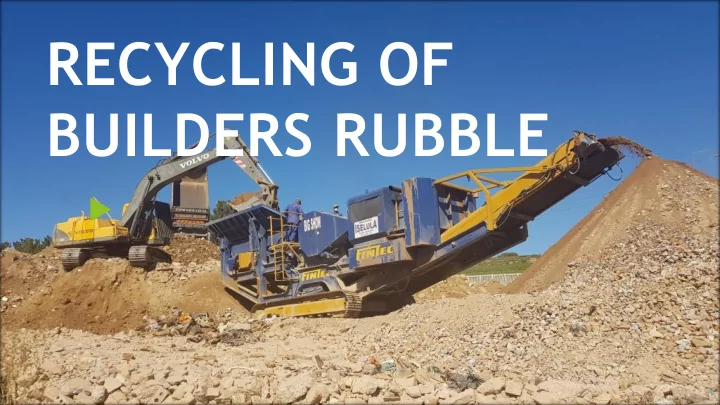

RECYCLING OF BUILDERS RUBBLE 1
The mission Introducing recycled/processed builder rubble into the Civil and Construction markets Challenges experienced to date: . Sorting materials from source • Changing the current mindset • sensitivity / distribution / capacity building • towards utilization of construction & demolition waste 2
Woolworths Distribution Centre, Montague Gardens, Cape Town Materials Recovered Concrete – fences, casting beds, pipes 4500 m 3 Brickwork 3500 m 3 Construction of local school Asphalt 2600 m 3 Returned to Much Asphalt for re-use Laterite from excavations 6800 m 3 Construction Materials Crushed concrete was applied in the base layers of the 30 000 m 2 warehouse building, while recovered brick was used to build a local school. All windows and doors were diverted to a salvage store. As such more than 90% of the waste generated by the demolition was re-used, with resulting cost savings for all projects involved as well as conservation of landfill airspace and avoided greenhouse gas emissions that are associated with the extraction, processing and transport of virgin construction materials. Savings Material cost savings: 4500 m 3 at R130/m 3 for G5 = R585 000 , excluding transport Landfill fees savings* on 17 400 m 3 , at 1.6 t per m 3 and R400/t = R1.1 million if the material was disposed of at landfill, rather than stockpiled. *R0 if clean loads, but at City of Cape Town landfills ~R400/t covers operational costs. 3
Hermanus berm – given a ‘new life’ in Overstrand Municipality’s headache is construction industry’s treasure Overstrand Municipality – a berm of builders’ rubble in Hermanus was created as a barrier between formal and informal residential areas. As part of building community in the area, the municipality wanted the berm removed. Iselula Crushing was able to provide the service by crushing and using the material in construction projects in the area, including fill material for a secondary school site in Stilbaai, fill and G5 material for roads and parking lots at a school in Hermanus, as well as sidewalks on various projects. Screened filling was also used by WA Bishops Transport for various projects around Hermanus and oversize/ pioneer aggregate was screened for use as drainage at the mall. Materials recovered:19 600 tonnes of rubble was processed and removed from the site. Saving: Landfill cost savings: Operational costs in Overstrand for 19 600 tonnes of rubble would have been R6 800 000 @ R340/t, excluding loading and transport costs. Material cost savings: R2 395 000 (Cost of virgin material less the cost to crush and re-use builders rubble) 4 4
Iselula Crushing – Blackheath site A secondary materials’ ecosystem Project description – Blackheath processing plant This materials hub receives between 5 700 and 22 000 m3 of builders’ rubble per month from local demolition and construction companies. Concrete, bricks and mortar are processed on-site to produce G4, G5, G7, G9 and kerbmix. Although originally seen as ‘contaminants’ in an aggregate producing business, other materials delivered to site have generated income opportunities for the surrounding community. Benefits Income opportunities There are 32 formally employed staff on-site Further income opportunities are available for 14 individuals in informal businesses Landfill diversion Between 5 700 and 22 000 m 3 of ‘waste’ is diverted from landfill every month (this probably also partly represents a saving of illegally dumped material). In the City of Cape Town, landfill operating costs are about R400/t, so assuming a bulk density of 1.6t/m 3 , between R3.6 and R14 million in landfill operating costs are saved every month. 5
Benefits in using recycled aggregates 1. Reduced tippage and related freight charges 2. Cheaper source of aggregate than newly mined 3. Reduction of landfill space required for rubble debris 4. Reduced haulage costs 5. Recycling also saves energy that would otherwise be used to mine, process, or transport new aggregates, which is also beneficial to the environment. 6. Produce specification size aggregates at own location. 6
Ensuring the Quality of recycled building rubble 1. Constant testing by SANAS approved labs is required to ensure minimum requirements are met. 2. Separation/sorting at source. 3. Quality control process control implemented to ensure all grades of aggregates. 4. Separation prior to crushing. 5. Quality control methodology once processed. 6. Faster construction if in-place recycling methods are employeed. 7
8
9
Current recycled aggregates being used in the market G5 (Sub- G7(filling) Subbase-53) G6 (fill G6 (fill-63) 63) Pioneer Layer Kerb-mix 10
Recommend
More recommend